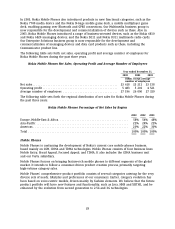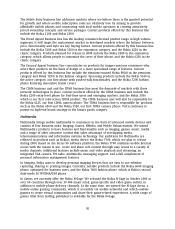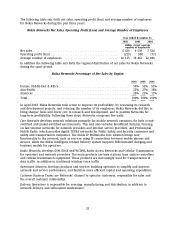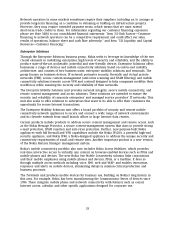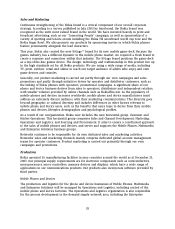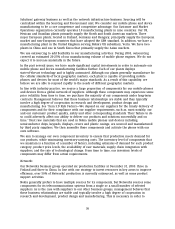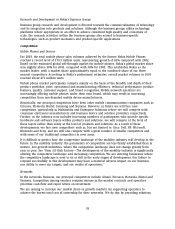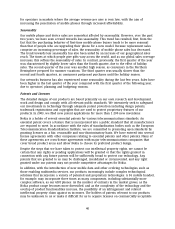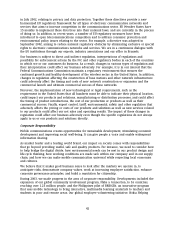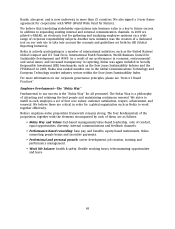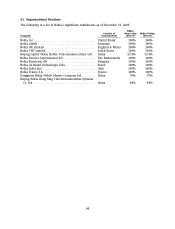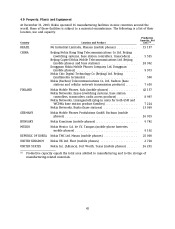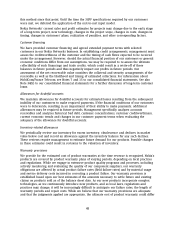Nokia 2003 Annual Report Download - page 39
Download and view the complete annual report
Please find page 39 of the 2003 Nokia annual report below. You can navigate through the pages in the report by either clicking on the pages listed below, or by using the keyword search tool below to find specific information within the annual report.is to ensure the introduction of new, interoperable mobile services worldwide. This is expected to
boost innovation by independent software producers as well as provide consumers with a wide
and varied selection of competitive, yet interoperable products and services.
Nokia Research Center
Looking beyond current product development, Nokia’s corporate research center develops
disruptive technologies and creates competencies in technology areas vital to the company’s future
success. The research center also supports Nokia’s four business groups by interacting closely with
them in order to develop new concepts, technologies, and applications.
Conducting research within a cooperative and global network underpins our long-term technology
visions and disruptive technology exploration. We cooperate with universities and other industry
players in research and development to widen the scope of technology.
Technology Platforms
As part of Nokia’s recent restructuring, the new Technology Platforms horizontal group was
created to serve Nokia businesses and external customers through the reliable delivery of leading
technologies and platforms. The Technology Platforms horizontal group brings together the
Technology, Mobile Software, Consumer Insights and Nokia Design units of the former Nokia
Mobile Phones and the Technology Modules from the former Nokia Networks. We expect that the
Technology Platforms horizontal group will continue to work together with developers, suppliers
and collaboration partners where we feel it is mutually beneficial.
Nokia’s platform creation strategy for its mobile phones and devices incorporates two aspects.
First, we develop standard technology platforms incorporating characteristics and components that
are often common across all product lines. These platforms include industry standard components,
such as microprocessors and operating systems, some of which are partly purchased from outside
suppliers and partly developed in-house. The standard platforms are configurable for different
business needs. Second, we develop high value-added software and radio technology designed
according to specific system standards. This enables us to offer a full product range covering all
major cellular and non-cellular standards with the minimum amount of specialization of
components. As a result, we have been able to outsource most of the components for our products,
while concentrating our efforts primarily on the development of high value-added software.
Nokia Mobile Software, now part of the Technology Platforms horizontal group, will provide
software solutions for mobile phones and devices. The key product is Series 60, a horizontal
terminal software platform, which allows a licensee to differentiate both its devices and its
services from those of its competitors. This key product has not yet been fully commercialized.
However, to date, Series 60 has been licensed to Panasonic, Samsung, Sendo and Siemens. Series 60
is also used in Nokia devices. The commercially available products based on Series 60 are the
Nokia 7650, the Nokia 3650, the Nokia N-Gage and the Nokia 6600. Series 60 runs on top of the
Symbian Operating System, which has wide support from the mobile industry as well as a very
active and large group of applications developers and operators. Further, Series 60 incorporates a
comprehensive suite of open applications technologies that have a key role in mobile services such
as multimedia messaging (MMS), Java and browsing. At the moment, revenue from our software
licensing activities is immaterial.
Additionally, Nokia Mobile Software serves a software developer community of more than one
million registered members by delivering architecture and developer platforms for Series 60,
Series 40 and Series 90 devices that harmonize technologies and provide true volumes.
38



